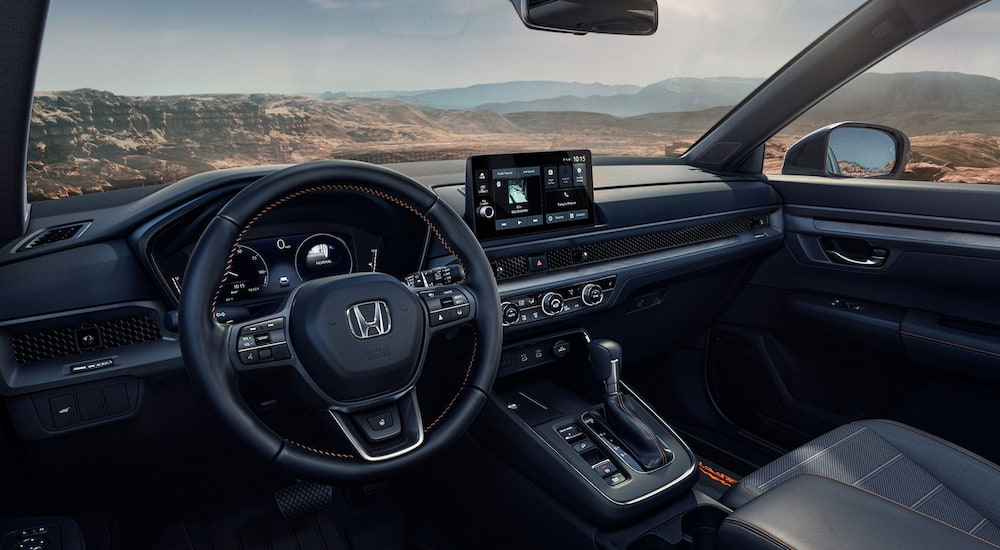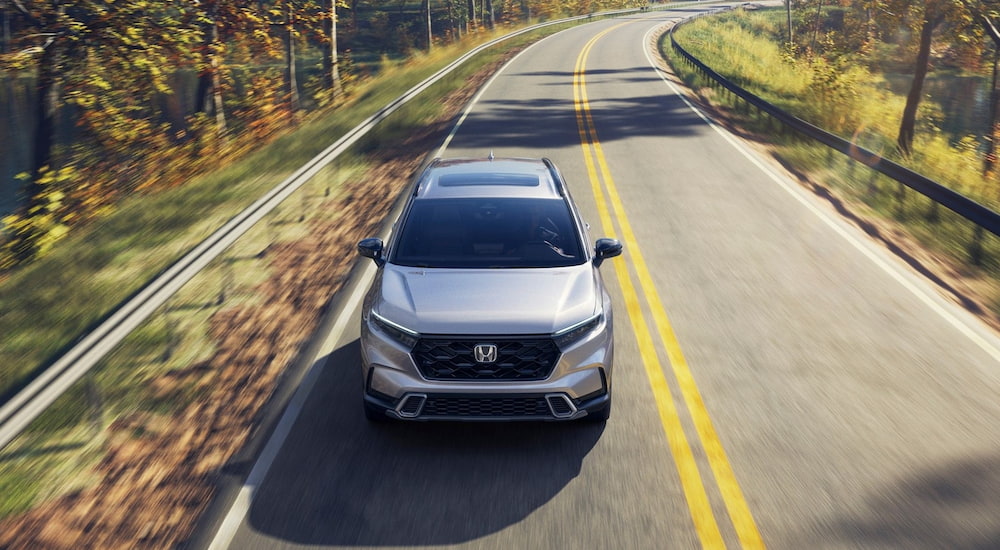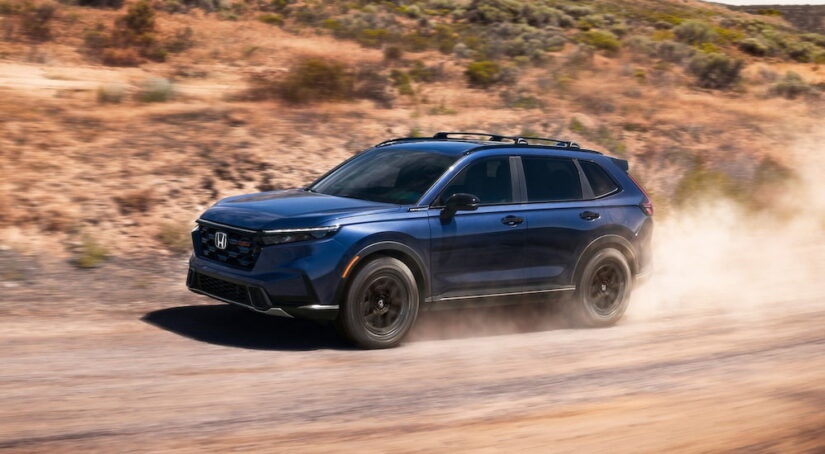It’s easy to argue that Honda created the compact crossover SUV segment when it first released the CR-V in 1995, and this model has continued to draw in drivers with its versatility, reliability, and efficiency, plus an ever-evolving slate of convenient tech features. More of these features than ever before come standard across the lineup on the refreshed 2026 model. If you’re looking to find a 2026 Honda CR-V for sale near you, you’ll probably want to learn a bit about your options first.
There are several variants available, and it’s smart to have an idea of which one you want before you venture out to your local dealership. So let’s take a look at the various ways that you can make the latest CR-V your own.
Engine Choices: Powertrain Options for Every Driver
The biggest question you have to ask yourself when buying a 2026 CR-V is whether you want a hybrid or a traditional gasoline vehicle. Both the hybrid powertrain and the conventional gas-powered engine have their own pros and cons, so it can be tricky to decide. To make it simple, let’s break it down into a few distinct categories: power, towing capacity, efficiency, and price.
Acceleration Advantage
Looking at the stats, it’s clear that the hybrid powertrain is the more powerful of the two. While the base engine produces 190 hp and 179 lb-ft of torque, the hybrid option produces 204 hp and 247 lb-ft of torque. That extra boost of power means you can accelerate more quickly and enjoy better driving dynamics out on the road.
Hauling Limits
You might think that more power means more towing capability, but it’s actually more complicated than that. That’s because the hybrid’s battery adds weight to the CR-V, so some of the power has to go toward moving a heavier vehicle around. In the end, the base gas engine can tow up to 1,500 lbs while the hybrid can tow up to 1,000 lbs.
Many compact SUV drivers don’t tow at all, but if you do like to use a trailer now and then and need more than 1,000 lbs of capacity, you’ll need to keep this in mind.
Fuel Savings
The 2026 CR-V’s base engine is impressively efficient for the class, delivering 30 MPG combined when paired with front-wheel drive and 29 MPG combined when paired with all-wheel drive. But as you might expect, the hybrid gets you much farther on the same amount of fuel, delivering 40 MPG combined with front-wheel drive and 37 MPG combined with all-wheel drive.
All of the fuel economy ratings mentioned so far are for combined city and highway driving, but there is one other difference when you look at the way these figures break down: the gas engine delivers its best fuel economy on the highway, while the hybrid delivers its best fuel economy in the city.
If you frequently run errands around town, choosing a hybrid can make your fuel savings even bigger than you might think when considering those combined figures. However, the hybrid is still more efficient than the non-hybrid, even if you’re just looking at the numbers for highway driving, so commuters and road trippers will also see a reduction in fuel costs by switching to the hybrid.
Cost Considerations
While the hybrid can save you money on fuel down the road, it does cost more up front. The hybrid powertrain is available on the top-tier trims of the CR-V, while the non-hybrid option is only on the more affordable base trims. If you’re on a budget, you might have to stick to the less efficient option.

Affordable Versatility: Base Trim Features
If you choose the non-hybrid powertrain, you get your pick of three different trims: LX, EX, and EX-L. The base LX trim receives some significant tech upgrades for the 2026 model year and now comes standard with wireless smartphone connectivity and a wireless charging pad, along with a nine-inch central touchscreen.
Upgrading to EX gets you comfort features like heated front seats and dual-zone climate control, along with extras like a moonroof and Smart Entry (no need to take your key fob out of your pocket to get into the cabin), among other perks.
The CR-V EX-L gets you a leather-trimmed interior, along with a variety of advanced tech features like a power liftgate, parking sensors, and an automatic-dimming rearview mirror.
Sporty and Efficient: Hybrid Trim Highlights
With the hybrid powertrain, you get a choice of four trims: Sport, Sport-L, Sport Touring, and (new for the 2026 model year) TrailSport. In addition to having a powertrain with more oomph, these trims also showcase their sportiness with special styling, including bright orange contrast stitching in the interior and gloss-black accents on the exterior.
The Sport trim comes standard with a lot of the same features as the EX, like heated seats, a moonroof, and dual-zone climate control. It also adds features like roof rails.
With the Sport-L, you add the perks from the EX-L trim to those of the Sport, gaining a leather-trimmed interior, athletic dual chrome exhaust finishers, a power liftgate, and an automatic-dimming rearview mirror.
The Sport Touring trim has a host of exclusive features, including a Bose premium sound system, a hands-free power liftgate, Google built-in, and rain-sensing windshield wipers. It also comes standard with all-wheel drive.
Rugged Appeal: The TrailSport
New for the 2026 model year, the TrailSport trim is the most rugged option in the lineup, coming standard with all-wheel drive, all-terrain tires, and special styling. Unfortunately for off-road enthusiasts, the special equipment ends there—this trim doesn’t have extra ground clearance or a specially tuned suspension. Still, it’s a solid choice for drivers who want a little extra rugged flair and the extra level of traction that AWD and all-terrain tires provide.
Traction Options: Front-Wheel Drive vs All-Wheel Drive
On most trims (other than the TrailSport and Sport Touring), you have the choice to get either front-wheel drive or all-wheel drive. As with the powertrains, there are a few factors to consider.
Front-wheel drive is the more affordable and more efficient option. However, all-wheel drive provides better traction, giving you extra confidence on unpaved roads or on paved streets during inclement weather.
Honda’s intelligent all-wheel drive system reduces the drop in efficiency by only powering the rear wheels when it’s needed, sticking with efficient FWD under ideal driving conditions.

Choosing Your CR-V: How to Decide
Figuring out which CR-V is right for you can seem difficult when you’re looking at all of the various differences between the seven available trims, but it gets a lot simpler if you break things down. Deciding between the two powertrains is a good place to start, which is why we made sure to fully explore the relevant factors in this guide. Making that choice automatically narrows things down to just three or four trims, which is much more reasonable than seven.
At this point, it’s generally easiest to start with your budget. Keep the value of your trade-in vehicle, your credit score, and the down payment you can afford in mind and determine your buying power (many dealership websites have simple tools to help with this). If multiple trims work for your budget, then it’s time to start seriously considering which features you feel are worth paying extra for.
Whether you prioritize comfort, technology, or style, you should have an easy time picking something that suits your needs and will keep you happy down the road.



